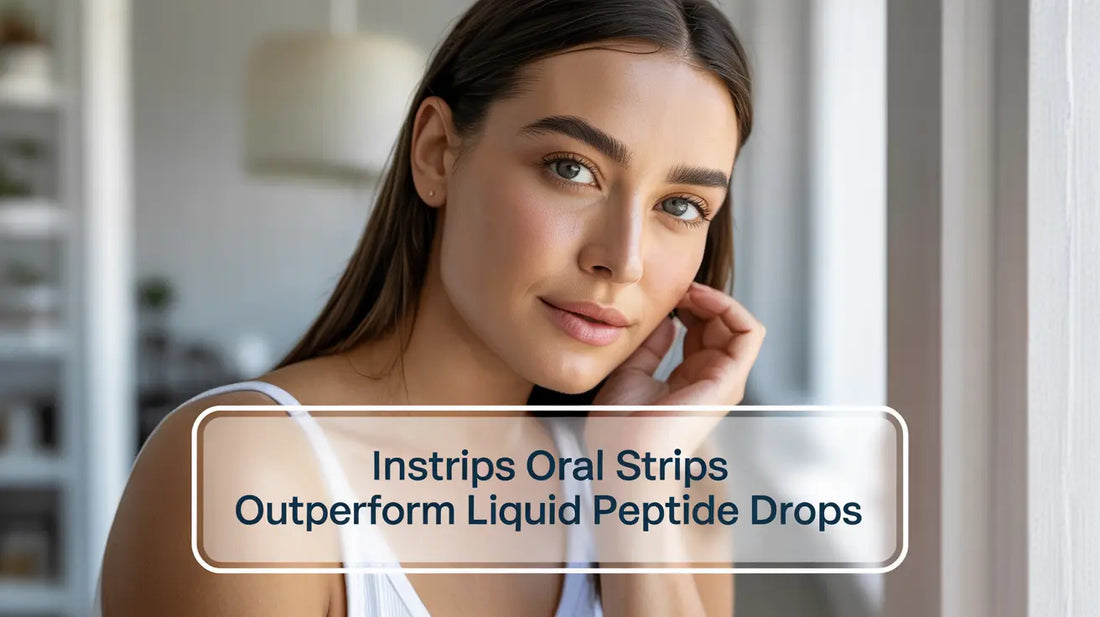
InStrips Oral Strips Outperform Liquid Peptide Drops - Here's Why
Share
InStrips oral strips deliver peptides more quickly, consistently, and conveniently than liquid drops.
In this article, you’ll learn:
- Why InStrips achieve higher bioavailability than drops
- Which use-cases favor strips vs. drops
- How each format impacts dosing precision, stability, and user experience
- What practical tips can boost your peptide delivery strategy
- Where to find more deep-dive resources and internal links
- When each format shines in day-to-day routines
Quick Comparison: Strips vs. Drops
A side-by-side glance shows why strips often come out on top.
- Bioavailability: Strips achieve 60–90% vs. 20–40% for drops when swallowed, thanks to mucosal uptake.
- Onset: Strips peak in 5–15 minutes, drops take 1–2 hours, ideal for rapid recovery.
- Dose precision: Strips ±5% consistency; drops ±10–20% based on dropper technique and user skill.
- Portability: Strips fit in a wallet or pocket; drops require bottles or travel vials and refrigeration.
- Ease of use: Strips need no measuring, just place and go, while drops require careful pipetting and timing.
- Stability: Strips tolerate room temperatures and brief humidity fluctuations; drops often need refrigeration, preservatives, or stabilisers.
- Waste & contamination: Zipped foil packs reduce contamination risk vs. open bottles that risk microbial growth.
- Cost considerations: Per-dose cost is higher for strips but balanced by reduced wastage and no needle supplies.
Why InStrips Excel Over Liquid Drops
Here’s what gives InStrips the competitive edge and elevates user compliance.
- First-pass bypass: Strips dissolve on mucosa, avoiding gut/liver degradation and ensuring more active peptide reaches circulation.
- Rapid uptake: Uniform film distribution and permeation enhancers like cyclodextrin boost sublingual absorption.
- Needle-free precision: Manufacturing ensures exact microgram dosing, no guesswork or injection errors.
- Travel-friendly: Single-dose blister packs prevent leaks, no cold-chain, ideal for business trips or vacations.
- User comfort: No needles, minimal irritation, and flavor masking options enhance compliance in clinical and consumer settings.
- Convenient disposal: Biodegradable strips and recyclable packaging align with sustainability goals.
- Consistent experience: Standardised manufacturing means each strip performs uniformly across batches.
When to Choose InStrips
Use strips in scenarios where speed, convenience, and consistency matter most.
- Immediate recovery: Pre- or post-workout peptide boost in minutes, perfect for athletes and biohackers.
- Consistent home dosing: Daily protocols without injection training or syringes.
- On-the-go use: Business travel, fieldwork, festivals, no bulky bottles or refrigeration.
- Needle aversion: Ideal for those uncomfortable with injections, seniors, or pediatric patients.
- Sensitive environments: Use in settings where needles are prohibited (e.g., airports, planes, secure facilities).
- Quick sampling: Clinical trials or pilot studies benefit from fast dosing and minimal setup.
When Liquid Drops Make Sense
Drops still offer advantages in specific, niche scenarios, even if strips dominate most use-cases.
- Fine-tuned titration: Research or clinical trials requiring microvolume adjustments (e.g., 2.5 µg increments).
- Multi-peptide blends: Combining multiple actives or supportive excipients (e.g., antioxidants) in one liquid solution.
- Cost-sensitive bulk use: Large-volume dosing where per-unit cost matters and refrigeration is available.
- Custom formulations: Drops allow addition of stabilisers, flavor enhancers, or pH adjusters for specialized needs.
- Extended mucosal contact: Drops can coat larger areas before swallowing, potentially increasing passive diffusion zones.
- Lab flexibility: Easy to prepare and adjust formulations in R&D labs for new peptide candidates.
Practical Tips for Best Results
Follow these best practices to maximize efficacy regardless of format and ensure reproducible outcomes.
For strips:
- Blot mucosa: use a clean tissue to remove excess moisture before dosing.
- Placement: center under the tongue or along cheek for targeted absorption.
- Hold still: rest tongue over strip and avoid talking, chewing, or swallowing until fully dissolved (20–60 seconds).
- Wait before intake: pause 5–10 minutes before eating or drinking to avoid wash-out.
- Rotate placement: alternate tongue and cheek to prevent local tissue fatigue.
- Inspect packaging: check each blister seal for integrity.
For drops:
- Calibrate dropper: practice consistent drop size and count.
- Swish before placement: clear oral cavity for better mucosal contact.
- Position correctly: hold drops under tongue for 30–60 seconds before swallowing.
- Minimize residue: rinse dropper tip after use to prevent blockages.
- Label bottles: date opened, expiry, storage notes.
- Store per guidelines: refrigerate if recommended and keep away from direct light.
Frequently Asked Questions
Here are quick answers to common questions, ready for schema markup and optimized for search.
What if I accidentally swallow my oral strip?
Swallowing sends the dose through the gut and liver, reducing uptake to 20–40% and nullifying the mucosal bypass benefits. Always let the strip fully dissolve in your mouth and wait at least 10 minutes before swallowing saliva.
Can I mix peptides in drop form together with strips?
Yes, use drops first, wait 10 minutes, then apply a strip for optimized dual delivery. This sequence provides initial mucosal uptake followed by sustained release via the strip’s film matrix.
How should I store drops vs. strips?
- Strips: Store at 15–25 °C, <60% humidity in original blister packs to preserve stability.
- Drops: Refrigerate if recommended; cap tightly, avoid light exposure, and discard after 30 days once opened.
Are there any safety concerns with using strips or drops?
Both formats are generally safe when used as directed. Ensure strips are from reputable manufacturers and drops carry proper labeling. Consult a healthcare professional if you have mucosal conditions or are on interacting medications.
